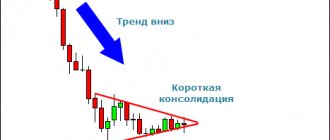Investing in exchange-traded assets has a high potential for profit. However, it is fraught with risks: if the price goes against the open position, losses are inevitable. There are special ways to protect against them, one of which is risk hedging.
The word "hedge" is translated as "fencing", "guarantee" or "insurance". Accordingly, hedging is risk insurance when investing in financial markets by opening an additional transaction in the opposite direction.
Let's look at an example of what hedging is on the stock exchange. Suppose an investor bought shares of Amazon or Sberbank, expecting their growth. If the price begins to fall, for example due to unfavorable news, the transaction will result in a loss instead of a profit. The purpose of hedging is to minimize or completely cover it. To do this, a deal is opened to sell, but not the stock itself, but a derivative (derivative financial instrument): futures or options. Having lost on the purchase of shares, the investor will earn by selling the derivative, partially or fully compensating for the losses.
The basic principle
The word “hedging” is derived from the English hedge, which means “insurance” or “protection”. This is one way to protect yourself from unnecessary market risks. It works on a simple principle:
• The investor receives a guarantee of maintaining the price of the asset in case the market situation changes.
• The investor agrees that if the market rises, he will receive less than the maximum profit.
One of the hedging participants acquires the ability to buy or sell an asset in the future under terms that are agreed upon in advance.
Let's look at the example of apples. Let’s say the standard price for 1 ton of them when selling in September is 30,000 rubles. But this figure is changing:
• In a good season, all producers have a large harvest. There is a high supply on the market. Accordingly, the price falls.
• During the weak season, farms receive smaller harvests. Due to low supply, the price per ton of apples rises.
Producers do not know what the season will be like and want to protect themselves from risks. They buy a forward contract to sell apples at a price of 30,000 rubles per ton.
What happens next is:
• The season turned out to be good - everyone had a big harvest. The market price per ton fell to 25,000 rubles. The farm sells 20 tons under a contract for 600,000 rubles. If sold at the market price, it would receive 500,000. The gain from the hedge is 100,000.
• The season turned out to be bad. The market price of a ton has risen to 35,000. The farm fulfills the contract and receives 600,000 rubles instead of 700,000. In this case, the other party to the contract, the buyer, benefits from hedging.
Potential profit or loss due to market changes is not always equal. Therefore, hedging requires a serious approach to calculations and understanding of the factors influencing the state of affairs.
Examples of derivatives
Futures example
Company A entered into a futures contract with a supplier on the stock exchange to purchase 1,000 tons of grain at a price of 12,000 rubles. per ton, and the wheat has just been planted. Experts suggested that due to the drought, the harvest would not be large and prices would rise. When the futures expiration date approaches, if this contract was not previously sold to another company, the following options are possible:
- The price of grain on the market has not changed - at the same time, both the seller and the buyer will not change their balance.
- The harvest turned out to be higher than expected, and the price of grain dropped to 10,000 rubles. per ton. Firm A will incur losses in the amount of 2,000 rubles. on each ton, which will need to be additionally charged to the supplier in addition to the contract amount.
- The price has risen, as the buyer expected, grain on the futures execution date is quoted at 13,000 rubles. per ton. In this case, company A receives the planned profit, and the supplier experiences a loss of 1000 rubles. for every ton, that is, the balance will decrease by this amount.
In addition to these financial flows, company A, when concluding a futures contract, paid the obligatory exchange interest - the guarantee of the transaction (from 2 to 10%, depending on the rules of the exchange).
NOTE! No real grain is transferred in a futures transaction.
Forward example
entered into a forward contract to purchase 100 of its shares in six months at a price of 200 rubles. per share. At the appointed time, representatives of “Verum” will transfer 20,000 rubles to the account of “Dilogy”, and representatives of “Dilogy” will provide “Verum” with 100 shares. There are no options. If the transaction was carried out through an intermediary, he is entitled to a commission, and there may be some overhead costs for processing.
Option example
- In 2016, the company purchased an option that allowed it to purchase 10,000 US dollars in a year at a price of 50 rubles. for a dollar. Since a year later the rate increased to 57 rubles. per dollar, this option turns out to be profitable, and the company will use it, making a profit of 7 rubles. for every dollar, that is, 70,000 rubles.
- The individual entrepreneur acquired an option for the right to sell his real estate in a year at a price of 250,000 rubles. per sq.m., counting on a fall in prices for new buildings. If this had happened, he would have exercised the option, sold the property and kept the difference, or, even more profitably, would have purchased a similar area at the market price, leaving a profit. However, in the Russian Federation there is a fall in prices on the primary real estate market, and at the time the option is exercised the price per sq.m. does not exceed 197,000 rubles. Such an option turns out to be unprofitable, and the owner, naturally, will not use it - he has such a right.
Who is involved in hedging and how?
The participant who protects himself from risks in hedging is called a hedger, and his counterparty is a business partner, another hedger. He also insures himself, but in the opposite direction.
Hedging instruments are any assets, even those that are not yet present in the portfolio, but are planned for acquisition:
• currency; • precious metals; • property and consumer goods; • securities; • lending rates; • commodities and energy resources.
In addition, a hedging contract also acts as a financial asset that can be sold or bought.
Example. An investor buys 100 shares of a company at a price of 800 rubles per share and hopes that the price will rise. But he knows that due to a number of factors that are difficult to predict, the price could collapse. Therefore, he acquires an option to sell the same 100 shares for 800 rubles in 6 months. An option gives the opportunity, but does not oblige, to make a transaction at this value.
When buying an option, he will pay the option premium. This is the amount that the buyer is guaranteed to receive if the investor does not proceed with the transaction.
After six months, there are two options:
• Stocks rose. The investor gives up the option and profits from the price increase.
• Stocks fell. The investor exercises the option and sells the shares for 800 rubles, minimizing losses.
The point is to optimize risks. The investor is protected from a major loss if the situation turns negative. When planning a hedge, you need to consider transaction costs (option premiums and commissions).
What opportunities does Forex investment insurance provide?
Funds held in foreign currency are subject to currency risks. As a rule, a company's accounting is maintained in one currency, which means that during the revaluation of items in foreign currencies, gains or losses are possible when exchange rates change. Currency risk hedging allows a company to protect its funds from unwanted or unpredictable movements in exchange rates. The company fixes the current value of funds by concluding transactions on the international foreign exchange market.
Hedging allows the company to avoid the risks of exchange rate fluctuations, plan further work and reflects the real financial result, which is not deformed by exchange rate volatility, indicating in advance the cost of products, company profits, wages and other costs.
Currency risk hedging
using leverage provides additional benefits:
- allows you not to extract significant funds from the company’s turnover
- makes it possible to sell currency that will be received in the future
Hedging a company's risks during foreign trade operations involves opening a currency position in the opposite direction of a future cash conversion operation.
For example, an importer, in order to purchase foreign currency, opens a position to buy foreign currency in advance and at the moment when the actual purchase occurs at his bank, he must close it.
The exporter, on the contrary, sells foreign currency and for this purpose opens a position to sell the currency in advance, and at the time of the actual sale closes this position.
Types of hedging
Hedging differs depending on the type of contract. They can be exchange-traded (futures or options) or over-the-counter (forwards or over-the-counter options).
Exchange contracts
Exchange contracts are opened on exchanges and, in addition to counterparties, there is a third party - the regulator. It ensures that contractual obligations are fulfilled. Exchange options and futures are independent assets that can also be sold or bought. Here's how they differ:
• Futures oblige counterparties to execute a transaction on pre-agreed conditions.
• An option gives the right to buy or sell a commodity under pre-agreed conditions. In this case, only one of the participants in the transaction will be obliged to fulfill it. It depends on the type of option:
• Call – option to buy. Gives the right to buy an asset at an agreed price. The seller will be obliged to sell it.
• Put – option to sell. Gives the right to sell an asset at an agreed price. The buyer will be obliged to buy it.
Advantages of exchange contracts: security of the contract, the ability to use assets in other transactions, quick search for a counterparty. Cons: the exchange puts forward strict requirements for operations and limits the choice of assets.
OTC contracts
Over-the-counter options and forwards are transactions concluded outside of an exchange, through intermediaries or directly. They occur rarely, are not regulated by a third party, and are not independent assets, meaning they cannot be involved in purchase and sale transactions. A forward is an over-the-counter analogue of a futures contract.
The advantage of such contracts is the greatest flexibility in the terms of the contract - no one limits the counterparties in the choice of assets, terms, prices and other provisions. True, there are significant disadvantages: a high risk of non-fulfillment of obligations, low liquidity (it is difficult to find a counterparty on your own), more significant expenses are possible.
If the parties participating in the transaction wish, hedging covers it in whole or in part. The second option is used when the risks are relatively small. Partial hedging is less expensive.
Hedging: why does an investor need it?
Hedging is a simple way that allows an investor to protect their positions in the market from the main risk - losses if the price goes against the transaction. This strategy is used by professional participants in stock trading. It is also available to private investors with small capital.
The risk hedging method allows you to partially transfer them to speculators, who make money not on long-term transactions, but on short-term price changes.
Hedging transactions in the foreign exchange market protects the investor from changes in the exchange rate, for example, of the dollar. Suppose the main forecast says that the dollar will rise in the near future, therefore, it is worth buying. But there is a possibility that some factor (a statement by the head of the central bank, a new coronavirus outbreak, unexpectedly weak macroeconomic data, etc.) will lead to a drop in price and losses on the transaction.
In order to insure portfolio risk, you can plan a transaction to sell the dollar with deferred execution. It might look like this:
- The main scenario is USD growth: trades to sell EURUSD, GBPUSD, buy USDCAD.
- Hedging scenario – USD fall: place a pending order to buy AUDUSD.
If the forecast does not work and the US dollar falls, the total risk initially included in the EURUSD, GBPUSD and USDCAD trades will be $150. An AUDUSD trade to hedge a portfolio must be placed to bring in a minimum of $150. In this case, losses can be avoided or even profit can be made if the defensive position gives a profit higher than the total risk from the main scenario.
Combining hedging contracts
Experienced players combine hedging instruments with each other, developing the least risky strategy.
Let's consider this using the example of a store purchasing apples. He plans to buy 30 tons of apples in September at a price of 30,000 rubles per ton, but worries that prices will rise if the harvest is bad. To protect itself from risks, but also not to lose benefits from a possible increase in value, the store enters into two transactions:
• Futures for the purchase of 30 tons of apples for 900,000 rubles. The deal is mandatory.
• Option to sell 30 tons of apples for 900,000 rubles. You can refuse this deal.
The option insures the store against losses on the futures. Here's how it works:
• The price increased to 40 rubles per ton. The store fulfills its futures obligations and buys apples below the current market price.
• The price dropped to 20 rubles per ton. The store fulfills its obligations under the futures (buys for 900,000), then exercises the option (sells for 900,000). Now you can purchase a batch at a favorable current price.
In both cases, the profit of the enterprise will be equal to the profit from the sale minus the costs of securing transactions.
Conclusion
Hedging is a delicate instrument that should not be approached without painstaking calculations. It protects against risk, but not against loss. Errors in planning lead to a situation in which the investor receives either a modest gain or a significant disadvantage. If you do not yet have extensive experience in managing cash, securities and other assets, it is better to take time to further study the area and give preference to traditional portfolio diversification.
Try the Right robot, a service that helps you choose stocks and bonds. Invest like a pro – without experience or special knowledge









